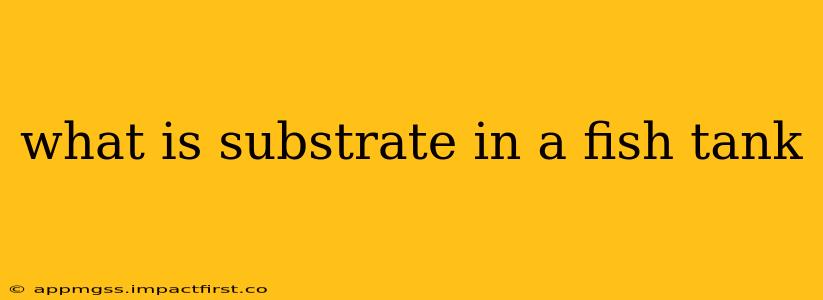Substrate—the material forming the bottom layer of your aquarium—is more than just pretty gravel. It plays a crucial role in your fish tank's ecosystem, impacting water quality, plant growth, and even the overall health and happiness of your finned friends. Understanding its importance is key to maintaining a thriving aquatic environment. This guide will delve into everything you need to know about fish tank substrate.
What are the different types of fish tank substrate?
There's a wide variety of substrates available, each with its own pros and cons. Choosing the right one depends heavily on your tank's inhabitants and the overall design you envision.
Gravel: This classic option is widely available, relatively inexpensive, and easy to clean. However, it doesn't offer much in the way of nutrient retention or beneficial bacterial colonization compared to other options.
Sand: A natural-looking alternative, sand provides a softer feel for bottom-dwelling fish. It's also excellent for plants with shallow root systems. Fine sand can, however, compact easily, hindering oxygen flow to the roots.
Plant Substrate: These specialized substrates are enriched with nutrients to support vigorous plant growth. They're often darker in color and designed to help roots establish themselves and thrive. This type of substrate is a must-have for planted tanks.
Aquarium Soil: Similar to plant substrate, aquarium soil provides essential nutrients for plants and contributes to a richer, healthier environment. It typically remains softer and more easily accessible to plant roots than some other options.
What is the purpose of substrate in a fish tank?
The substrate serves several vital functions within your aquarium:
-
Aesthetics: It forms the visual base of your tank, setting the tone for the overall design and enhancing the beauty of your aquatic landscape.
-
Biological Filtration: The substrate provides a habitat for beneficial bacteria that break down waste products, helping to keep your water clean and healthy.
-
Plant Growth: For planted tanks, the substrate provides essential nutrients and anchorage for plant roots. The type of substrate you choose dramatically impacts plant health.
-
Habitat for Invertebrates: Some invertebrates, such as certain snails and shrimp, utilize the substrate for food and shelter.
How do I choose the right substrate for my fish tank?
Selecting the appropriate substrate hinges on several factors:
-
Fish Species: Bottom-dwelling fish might require a softer substrate like sand to prevent injuries. Active swimmers might be less sensitive to substrate type.
-
Plants: Planted tanks need a nutrient-rich substrate like plant substrate or aquarium soil. Gravel or sand alone may not provide enough nutrients for healthy plant growth.
-
Tank Size and Design: The substrate's color and texture should complement your tank's overall aesthetic. The quantity needed will, obviously, depend on the tank's dimensions.
-
Maintenance Preferences: Some substrates are easier to clean and maintain than others. Consider your comfort level with different cleaning techniques.
What are the benefits of using a planted substrate?
Planted substrates offer several significant advantages:
-
Nutrient Delivery: They supply essential macro and micronutrients directly to plant roots, promoting faster and healthier growth.
-
Improved Water Quality: Healthy plants help absorb excess nutrients, contributing to cleaner water and reducing the need for frequent water changes.
-
Enhanced Ecosystem: They support a more diverse and balanced ecosystem within the tank, fostering a healthier environment for all inhabitants.
How often should I clean my fish tank substrate?
The frequency of substrate cleaning depends on several factors, including tank size, the number of fish, and the type of substrate. Generally, you should aim for partial substrate cleaning (siphoning out debris) every 2-4 weeks and a more thorough cleaning (potentially vacuuming) every few months. Always avoid excessive cleaning, as it can disrupt the beneficial bacteria colonies vital for water quality.
Can I use aquarium gravel as substrate for a planted tank?
While you can use aquarium gravel for a planted tank, it's not ideal. Gravel generally lacks the necessary nutrients to support vigorous plant growth. You may find that your plants struggle to thrive unless you supplement with liquid fertilizers. A dedicated plant substrate or aquarium soil is a much better choice for a thriving planted tank.
By carefully considering these factors and understanding the crucial role of substrate in your aquarium's ecosystem, you can create a thriving and beautiful underwater world for your fish and plants. Remember that proper research and thoughtful planning are key to success in fishkeeping.
